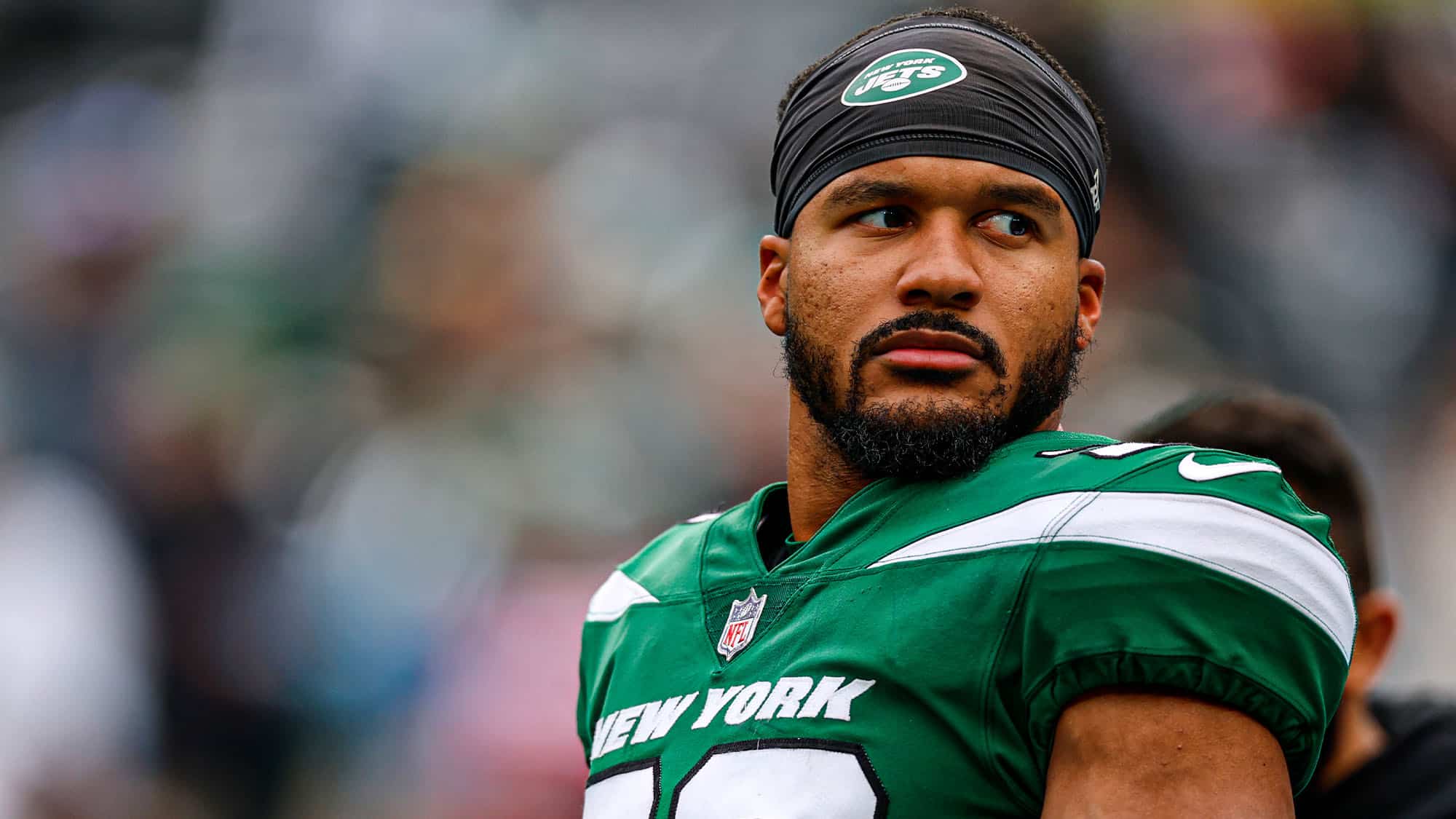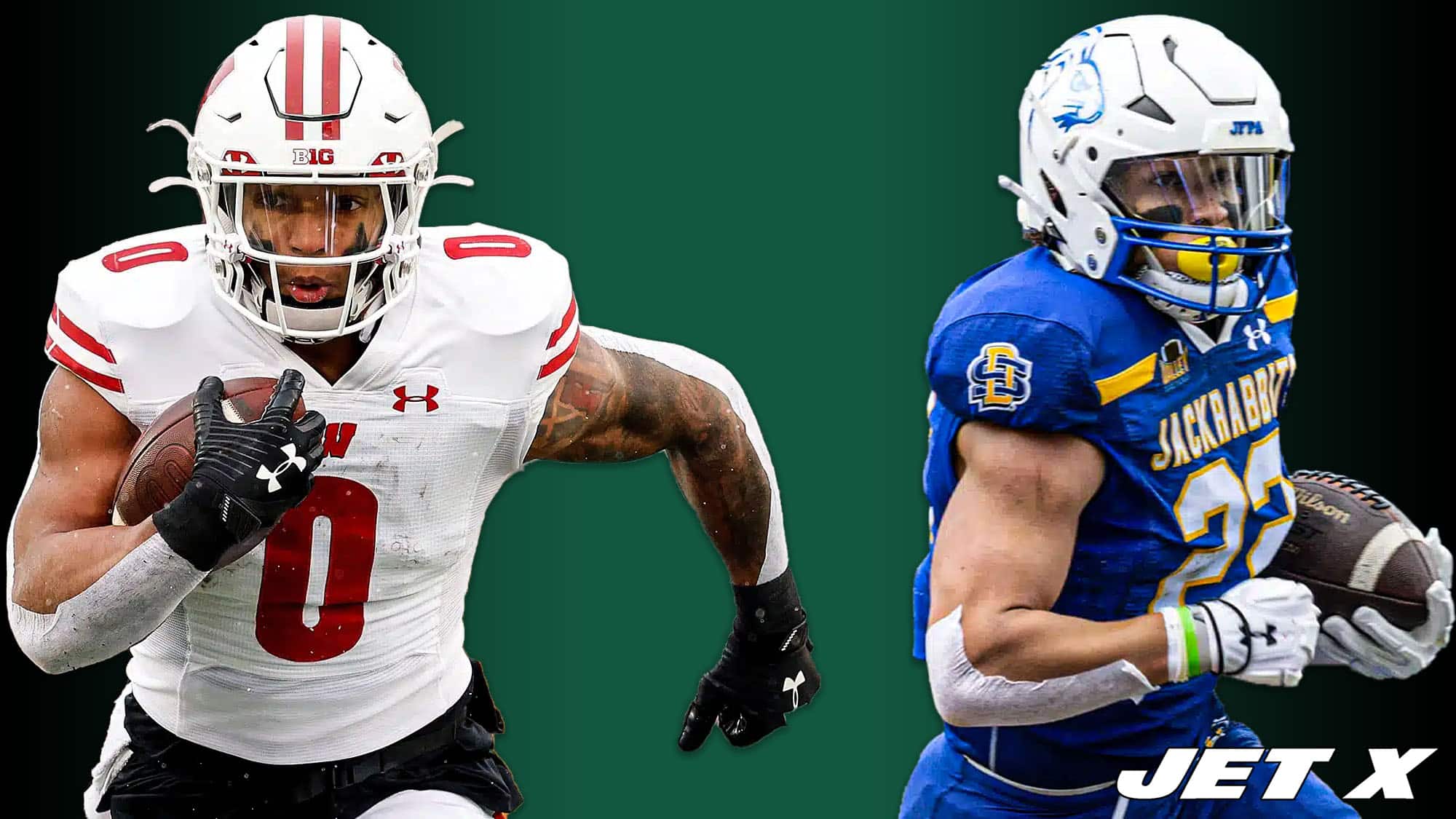New York Jets have to replace a massive chunk of production on defense
It’s been an undeniably stellar offseason for the New York Jets. Through free agency, the trade market, and the draft, general manager Joe Douglas aggressively attacked all of the issues that plagued an abysmal offense in 2023. Provided they stay healthy, the Jets are poised to be one of the better offensive teams in the NFL. Even if injuries do strike, the Jets are prepared to weather the storm thanks to their much-improved depth.
These offensive improvements are more than enough to make this a tremendous overall offseason despite the concerns I’m about to mention. Nonetheless, this offseason did raise some significant questions about the outlook of the defense, and those questions are worth discussing.
This Jets offseason was not without its share of key losses on defense, mainly coming in the trenches. With the recent trade of defensive end John Franklin-Myers, the Jets have now lost three of their five best pass rushers from last season:
- Quinnen Williams: 70 total pressures, 5.5 sacks
- Bryce Huff: 67 total pressures, 10.0 sacks (Signed with PHI)
- Jermaine Johnson: 56 total pressures, 7.5 sacks
- John Franklin-Myers: 50 total pressures, 3.5 sacks (Traded to DEN)
- Quinton Jefferson: 29 total pressures, 6.0 sacks (Signed with CLE)
Total pressures via PFF
After that top-five, the next-best pass rusher in terms of total pressures was Solomon Thomas with only 17. The Jets relied heavily on those five players to anchor the pass rush.
In Huff, Franklin-Myers, and Jefferson, the Jets have lost a combined total of 146 total pressures and 19.5 sacks. That’s 42% of the team’s total pressures and 41% of its sacks.
With two-fifths of their pass-rush production out the door, it raises the question: How are the Jets going to replace all of those pressures and sacks?
Three players will be counted on the most.
Haason Reddick
After losing Huff, trading for Haason Reddick was a vital coup for Joe Douglas. Without Reddick on the roster right now, the Jets would be looking at the possibility of a substantial defensive drop-off in 2023. They simply wouldn’t have the reinforcements to make up for the excellent trio they lost. But with the superstar production of Reddick added to the team, the Jets are well-positioned to match the production they lost in Huff, Franklin-Myers, and Jefferson.
In 2023, Reddick tied for 15th among edge rushers with 67 total pressures – the same total as Huff. He needed 223 more pass-rush snaps than Huff to pull it off, though.
From a snap-count perspective, I view Reddick as more of a Franklin-Myers replacement than a Huff replacement. Huff is a situational player. Reddick and Franklin-Myers are much different players, but they are both three-down linemen who can be trusted to play over half of the snaps. With Franklin-Myers’ starting spot vacated, we can easily project Reddick and Jermaine Johnson as the Jets’ two starting edge defenders.
Last season, Reddick played 74% of the defensive snaps while Franklin-Myers played 55%. Most likely, Reddick will find a middle ground between those two numbers. The Jets like to keep their defensive linemen well-rested, so Reddick is unlikely to come close to the 74% number (Jermaine Johnson led all of the team’s edge defenders with a 66% snap count last year). But with the Jets counting on Reddick to dominate as a pass rusher in the wake of the Huff and Franklin-Myers trades, I think he will surpass Franklin-Myers’ 55%.
My prediction would be that Reddick plays around 60% of the snaps. Remember, the Jets will probably try to keep him under the 67.5% benchmark that would force them to send a second-round pick to Philly instead of a third-round pick (if he also gets 10 sacks).
As the pseudo replacement for Franklin-Myers, Reddick should be a sizable upgrade in the passing game. Reddick generated 67 pressures last year and 68 in 2022. He’s also generated double-digit sacks in four consecutive seasons with an average of 12.6 per year. Even though his snap count will likely decline – which is worth noting since his high snap counts certainly helped inflate his production – his efficiency is poised to improve since he will be better-rested and will play fewer snaps in coverage.
Look for Reddick to generate similar production as he did in the past, but on fewer snaps, making him a more efficient player.
Will McDonald
The Franklin-Myers trade finally gave us a clear outlook for the role of Will McDonald.
Before the trade, it was tough to figure out where McDonald would get more snaps from. The Jets’ only change to the EDGE unit was letting Huff walk and replacing him with somebody who plays more snaps than him. How could he have possibly found more snaps? But now that Huff and Franklin-Myers are gone, we can easily project McDonald as the Jets’ Huff replacement.
Huff played 42% of the Jets’ snaps last year. This is a reasonable ceiling for McDonald. Perhaps he will fall a bit lower if we’re projecting Reddick to out-snap Franklin-Myers, taking some snaps away from McDonald. So, it seems realistic to project McDonald at somewhere from 35-40%.
Replicating Huff’s efficiency is a tall order for McDonald. It remains to be seen how Huff will perform in a larger role with Philadelphia, but in his role with the Jets, Huff continuously generated unbelievable numbers from an efficiency perspective. His 20.06% pressure rate in 2023 trailed only Micah Parsons’ marginally better 20.08%.
The good news is that McDonald’s pass-rush efficiency as a rookie was actually impressive, even if he was nowhere close to Huff. His 12.1% pressure rate ranked 50th out of 132 qualified edge rushers (min. 90 pass-rush snaps), placing him in the 63rd percentile. McDonald’s 16.7% pass-rush win rate was even better, as he ranked 21st out of 132 qualifiers (85th percentile). To get even more specific, his 22.7% pass-rush win rate in true pass set situations ranked 18th (87th percentile), placing him just 12 spots behind sixth-ranked Huff (29.1%).
While all of that occurred over a small sample of just 99 pass-rush snaps, it’s still a promising jumping-off point for McDonald as he enters his second season. If he makes the large year-two leap that you expect to see from a first-round pick, McDonald could come close to matching Huff’s production.
Plus, McDonald registered his numbers in a less favorable role than the one he will play as Huff’s replacement. Yes, McDonald registered a very low snap count that kept him fresh, but he wasn’t restricted to high-likelihood passing situations like Huff. McDonald faced a run play on 45% of his defensive snaps. Huff’s rate was a minuscule 28%. Huff was able to pin his ears back and fly on every rep because run plays were unlikely when he was on the field. For McDonald, the run-pass likelihood was almost a coin flip, so he had to sit back patiently and prepare for both threats, hurting his ability to explode off the ball as a pass rusher.
Moving into Huff’s role will naturally improve McDonald’s pass-rush efficiency. One stat emphasizes the drastic difference in pass-rush favorability that McDonald will experience if the Jets slide him into the same role that Huff was playing.
Huff faced a true pass set on 60.2% of his pass-rush snaps, ranking seventh-highest out of 132 qualified edge rushers. McDonald’s rate was just 47.5%, ranking 82nd. This stat is important because true pass sets are substantially more favorable for edge rushers than non-true pass sets. The more often you face them, the better chance you have of making plays.
In 2023, the league-average pressure rate for edge rushers on true pass sets was 16.9%. That is nearly double the rate on non-true pass sets, which was 8.9%. Huff’s high frequency of obvious pass plays allowed him to face more true pass set situations, boosting his production, while McDonald faced these situations at a low rate, hurting his production. This is especially meaningful for McDonald in particular when considering how fantastic his true pass set win rate was (reminder: 18th of 132 at 22.7%, just 12 spots behind Huff’s 29.1%). He didn’t get enough opportunities to maximize that skill.
In Huff’s role, McDonald will have a much better chance of producing as a pass rusher. Add a year-two leap on top of that, and McDonald surely has a chance of replicating Huff’s efficiency.
And, let’s be clear: As it pertains to the Jets’ ability to replicate the production of the Huff/JFM duo, McDonald doesn’t have to match the sky-high bar set by Huff. Reddick is going to be a large upgrade over Franklin-Myers in the starting spot opposite Jermaine Johnson. So, if McDonald can just come reasonably close to Huff, he and Reddick should be able to combine for similar production as a duo.
With McDonald and Reddick, the Jets are in a good spot to replicate the production of Huff and Franklin-Myers.
Javon Kinlaw
I’m more concerned about the Jets’ interior pass rush than their edge rush. Quinton Jefferson was an excellent pickup last year. The Jets elected to let him walk and replace him with an objectively worse player.
Javon Kinlaw actually had more pressures (31) than Jefferson last year (29), but he played three more games and had 82 more pass-rush snaps. Despite Kinlaw’s big edge in playing time, Jefferson still had more sacks (6.0 to 3.5) and quarterback hits (13 to 6).
In terms of efficiency, it was no contest. Kinlaw was an above-average interior pass rusher in 2023, but Jefferson was a great one. Among the 98 defensive tackles with at least 200 pass-rush snaps, Jefferson ranked ninth in pressure rate (12.1%), 12th in pass-rush win rate (14.0%), and 13th in true pass set win rate (20.4%). Kinlaw was 33rd in pressure rate (9.6%), 39th in pass-rush win rate (10.3%), and 20th in true pass set win rate (18.1%).
The gap between Jefferson and Kinlaw is especially concerning because this was Kinlaw’s best year by a longshot. While the drop-off from Jefferson to Kinlaw will not be enormous if Kinlaw plays at the same level as he did last year, it’s not guaranteed he will replicate his 2023 season. Kinlaw’s production spiked in a contract year.
Over his first three seasons, Kinlaw was not a productive player, registering 1.5 sacks and 5 quarterback hits in 24 games with a below-average 5.9% pressure rate. Injuries were also a huge problem as he missed 28 games. So, how do we know 2023 was a sign of things to come rather than an anomaly? We don’t, which is why giving Kinlaw $7 million was a questionable choice at best.
Meanwhile, Jefferson’s 2023 season was nothing new. In the previous season with Seattle, Jefferson had 5.5 sacks and 42 pressures with an 11.7% pressure rate.
Somehow, Jefferson only landed a one-year, $4 million contract with Cleveland while Kinlaw netted one year and $7 million from the Jets. In an offseason where most of the Jets’ decisions have been admirable, this is the one move that I truly struggle to comprehend.
It seems likely the Jets will experience a downgrade at this position. If Kinlaw can maintain his 2023 production (and stay healthy), the drop-off won’t be massive – although it will still be noticeable. However, if Kinlaw reverts to the level of play and durability he showed over his first three seasons, the drop-off will indeed be a massive one.
Overall expectations
Altogether, I think it’s fair to expect a minor drop-off from the Jets’ pass rush this year.
Reddick is a key floor-raiser. Having him will prevent the drop-off from being too large regardless of how McDonald and Kinlaw perform. This is not going to be anywhere close to an “average” pass rush with Quinnen Williams, Jermaine Johnson, and Reddick on the team.
However, the Jets are taking major gambles on McDonald and Kinlaw. If both hit their ceilings, the Jets’ pass rush should be just as good as it was last year. However, McDonald has a high bar to clear as he replaces the most efficient situational pass rusher in the NFL, and the Jets are expecting a lot from him after they barely put him on the field as a rookie. Meanwhile, the gap between Kinlaw’s career body of work and Jefferson’s makes it difficult to see him matching Jefferson.
Hopefully, McDonald does take a gigantic leap and replicate Huff, allowing him to combine with Reddick to form an even better duo than Huff/JFM. And hopefully Kinlaw matches his 2023 season to keep the drop-off from Jefferson as minimal as possible. If these things happen, the Jets will improve upon their pass rush from last year.
While that outcome is certainly a feasible possibility, it’s the best-case scenario. To keep it realistic, we should pinpoint the middle ground as the likeliest expectation. If Reddick is the same player he’s been, McDonald has a solid season but is not close to Huff, and Kinlaw drops off a bit from 2023, the Jets will maintain an excellent pass rush while probably being slightly worse than a year ago.
Using some of the numbers and projections we broke down today, here are my ballpark guesses of the stats we could see from this trio if they all play 17 games:
- Reddick: 60 total pressures (on 400 pass-rush snaps with 15.0% pressure rate), 10.0 sacks
- McDonald: 48 total pressures (on 300 pass-rush snaps with 16.0% pressure rate), 6.0 sacks
- Kinlaw: 24 total pressures (on 300 pass-rush snaps with 8.0% pressure rate), 3.0 sacks
Here is a comparison between my projection for this trio and the combined 2023 stats of Huff, Franklin-Myers, and Jefferson:
- Projected Reddick/McDonald/Kinlaw: 132 pressures on 1,000 pass-rush snaps (13.2% pressure rate), 19 sacks (1.9% sack rate)
- 2023 Huff/Franklin-Myers/Jefferson: 146 pressures on 933 pass-rush snaps (15.6% pressure rate), 19.5 sacks (2.1% sack rate)
It’s a drop-off, but a small one. If all else remained equal, the Jets’ pass rush could still probably rank top-8.
Last year, the Jets were sixth in sack rate and fourth in pressure rate (per Pro Football Reference), making it fair to label them as an approximate top-five pass rush. I’d estimate the decline from last year’s trio to this trio might drop them two or three spots on that list. Nothing major – certainly worthwhile for the immeasurable improvements made on offense. With the talent the Jets have at cornerback and linebacker, a top-8 pass rush should still allow them to field an elite defense, while the offense is going to be lightyears better.
And it’s not all on the shoulders of these three players. Even if my predictions hold true, the Jets can find pass rushing improvement from other players, specifically Jermaine Johnson. What if he takes another leap in year three similar in size to the one he took last year, turning him into a megastar? That is another way the Jets can recoup some of the production they lost.
Ultimately, I think the Jets did a nice job of positioning themselves to survive three major losses from the unit that anchors their defense. The size of the drop-off – or if there even is one – will mostly come down to McDonald’s development. How big of a leap does he take? Kinlaw is a key X-factor as well.
But Reddick is the buoy. Douglas may have saved the defense with that move.
Without adding Reddick’s reliable track record of star-level production, the floor of the Jets’ pass rush would be alarmingly low. With Williams and Johnson as the only sure things, the pass rush would’ve had a legitimate possibility of being below-average if the high-variance players (McDonald/Kinlaw) did not pan out. That would be a killer. The Jets rely heavily on their four-man rush to be successful defensively. If they had a below-average pass rush, their elite defense would suddenly not be elite, eliminating the crown jewel that has made the Jets feel like they are only a competent offense away from playoff contention.
Thanks to Reddick, though, Jets fans can feel comfortable about their pass rush at least being “good” in 2024 as a worst-case scenario, regardless of McDonald and Kinlaw’s production. A “good” pass rush would allow the Jets’ defense to remain great overall, even if it is not quite as elite as last year. If that happens to be the cost of building a great offense, so be it.
With McDonald’s sky-high ceiling, though, that trade-off may never come into play. He has a chance to make it so the Jets do not feel the losses of three pass rushers who combined for nearly 150 pressures and 20 sacks, which would be incredible to pull off. Joe Douglas was panned for the McDonald selection one year ago, but now, it could end up paying enormous dividends.
We have to see him make the leap first, though. Will McDonald, the spotlight is on you.












Good analysis. Personally, I have my doubts that Kinlaw & McDonald can fill the JFM role. Riddick may be able to fill the Huff role. I agree it may be best to hope for the best (improvement in overall D line play) while preparing for a slight regression.
Great piece as usual.
It’s also very possible Kinlaw, a young player, is still ascending and will improve on last year’s effort, as well as McDonald. Jefferson, and JFM, are likely at their “ceiling” as players, yes you know what you’ll get but it can be said, based on their age and physical traits that both Kinlaw and McDonald have the ability to pass the production of both Q and JFM. Sure, by making the move to “projected ability” the Jets gave up some level of certainty for the opportunity to improve….which could happen, and is more likely with younger players who are still developing. I’ve said it already, Saleh has proven his ability to develop and get more out of defensive players, I’m giving them the benefit of the doubt on this one.